Barone Ricasoli
by
KL Sullivan
Summary: A wine tasting at Barone Ricasoli is wonderful especially if you call ahead for an appointment. To the right of the “Wine Shop” is a large, elegant room, which enhances the tasting experience. The wall of glass windows looking into the elegant office area with a winding staircase gives one the idea of the magnitude of the wine operation at Barone Ricasoli.
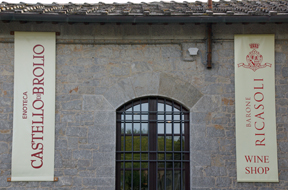 After our historical tour which had been recommended to us, our tour guide, Milena Mihaljevic, gave us a guided tour of the winery, ending with a delightful wine tasting.
After our historical tour which had been recommended to us, our tour guide, Milena Mihaljevic, gave us a guided tour of the winery, ending with a delightful wine tasting.
The winery and tasting rooms are located in more recent buildings than the 12th century castle. Currently the winery produces two million bottles (167,000 cases) of wine each year. The winery exports 70 percent of the wine produced.
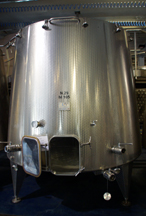
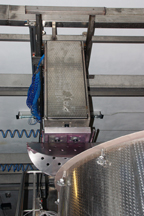 For pressing grapes, a gravity flow system is used. The stainless steel tanks are unusual in shape, large at the bottom as they narrow at the top. This allows the plunging down to be done by a machine. This plunger moves easily from tank to tank. The winery designed this machine plunger. The unusual shape of the stainless steel tanks accommodates the specially designed plunger. Currently another building is under construction for housing additional stainless steel tanks.
For pressing grapes, a gravity flow system is used. The stainless steel tanks are unusual in shape, large at the bottom as they narrow at the top. This allows the plunging down to be done by a machine. This plunger moves easily from tank to tank. The winery designed this machine plunger. The unusual shape of the stainless steel tanks accommodates the specially designed plunger. Currently another building is under construction for housing additional stainless steel tanks.
The current baron started replanting the grapevines in 1995. He uses the DOCG spacing requirement of 6500 plants per hectare. Before taking over the winery and vineyards, his chosen profession had been photography. However, he became interested in increasing the quality of wines with the Barone Ricasoli label.
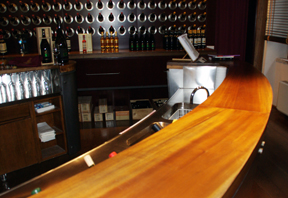 The tasting room is the largest we have seen in Chianti. Entering the large one hundred year old building, labeled Wine Shop, we saw glass enclosed winery items for sale. Near the back of the room is a lovely curved counter where visitors can taste wines, if they arrive without an appointment for a tour. Numerous black and white pictures from the 1930's of olive oil processing are located on a large table in the center of the wine shop. Previously, the building had been an olive oil mill. Today with many acres of olive trees, the winery no longer processes their own olive oil. Like many Italian wineries, their olives are sent to a mill.
The tasting room is the largest we have seen in Chianti. Entering the large one hundred year old building, labeled Wine Shop, we saw glass enclosed winery items for sale. Near the back of the room is a lovely curved counter where visitors can taste wines, if they arrive without an appointment for a tour. Numerous black and white pictures from the 1930's of olive oil processing are located on a large table in the center of the wine shop. Previously, the building had been an olive oil mill. Today with many acres of olive trees, the winery no longer processes their own olive oil. Like many Italian wineries, their olives are sent to a mill.
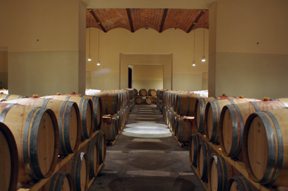 After viewing the large tanks, we went back to the “Wine Shop” to access the cellar. Wine is aged in French oak barrels and continues aging in bottles stacked in large crates. Above this room is the bottling room where staff was busily labeling wine. This was the largest bottling machine we have seen. In addition, a machine was placing the cardboard inserts into the case boxes.
After viewing the large tanks, we went back to the “Wine Shop” to access the cellar. Wine is aged in French oak barrels and continues aging in bottles stacked in large crates. Above this room is the bottling room where staff was busily labeling wine. This was the largest bottling machine we have seen. In addition, a machine was placing the cardboard inserts into the case boxes.
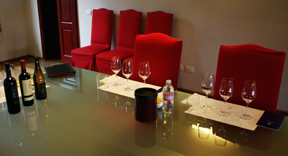 At the end of the winery tour, Milena invited us into a large rectangular room. In the center of the room was a large table with chairs draped in red. At the end of the table, a select group of wines was on the table. Two place settings were set. Each place setting had a wineglass marking with the name of the wine for the three wines we were to taste. These placemats were in English for us but they are also available in other languages for visitors of other nationalities. Our guide discussed each wine we were about to taste and gave us plenty of time to enjoy the tasting. A basket of crackers was also available for the tasting. Three Schott wine glasses were set on the placemats, one for each wine.
At the end of the winery tour, Milena invited us into a large rectangular room. In the center of the room was a large table with chairs draped in red. At the end of the table, a select group of wines was on the table. Two place settings were set. Each place setting had a wineglass marking with the name of the wine for the three wines we were to taste. These placemats were in English for us but they are also available in other languages for visitors of other nationalities. Our guide discussed each wine we were about to taste and gave us plenty of time to enjoy the tasting. A basket of crackers was also available for the tasting. Three Schott wine glasses were set on the placemats, one for each wine.
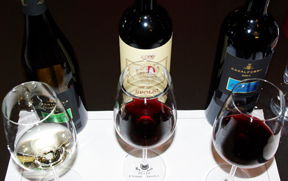 Torricella is 100 percent Chardonnay. It is aged six months in new French oak and six months in bottles. It has a fruit and oak bouquet, fruit flavor and a slight oak taste. This wine has a crisp finish and a long aftertaste.
Torricella is 100 percent Chardonnay. It is aged six months in new French oak and six months in bottles. It has a fruit and oak bouquet, fruit flavor and a slight oak taste. This wine has a crisp finish and a long aftertaste.
Brolio 2005 is a Chianti Classico DOCG. It has black cherries and fruit on the nose and a fruit taste. It is crisp and cleansing. This wine is aged one year in wood and six months in the bottle. Barone Ricasoli produces five hundred thousand bottles (about 42,000 cases) each year.
Our last wine tasted was a Super Tuscan. Casalferro 2003 Toscana IGT is a Sangiovese and Merlot blend. It is aged for 18 months in new oak barrels followed by another 18 months in bottles. The color is a very dark, opaque purple. It has a fruit nose, a red fruit taste. Acid and tannins are on the finish. Depending on the year, the winery produces 100,000 to 200,000 bottles of this blend. Only during good years does Barone Ricasoli produce this wine.
In this tasting room, four large baskets are filled with stones. These stones are representative of the soil in which the vineyards are established. Stones included slate (galestro), sandstone (arenaria), stones of houses (alberese) and ciottolo (alluvionale.)
Although one of the largest wineries in Italy, they are very friendly and offer an excellent tour in several languages. We believe you will enjoy a visit to Barone Ricasoli.
Related article about Castello di BrolioVisit these tour operators that partner with Wine Trail Traveler.
 |
||||
|
Spain and Portugal |
SmoothRed London, England, United Kingdom |
